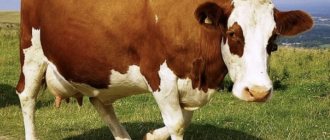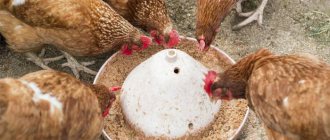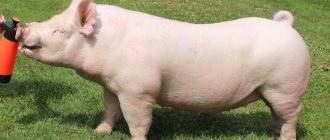Determining readiness for crossing
The sow gives birth to two litters annually. In one survey she brings from 5 to 15 individuals. An important factor in the effectiveness of this direction is relatively small investments.
When raising pigs, it is important for the farmer to know exactly the timing of the survey. To do this, you need to have an idea about the timing of pregnancy and methods for determining pregnancy in patients under your care. It is equally important to correctly determine the time when an individual is ready for mating in order to promptly send a boar to her.
Despite the fact that, from a physiological point of view, a pig of 5-6 months already shows the first signs of sexual heat, at this age it is not recommended to bring it together with a male.
For the first mating, the age of 9 months is required, when the individual gains about a hundredweight of live weight.
Signs of readiness for mating:
- refusal of food;
- the genitals become red;
- restless behavior.
In the presence of a male, the female demonstrates her readiness by remaining in one place for a long time. The hunting period lasts from 2 to 4 days. At this time, you need to have time to introduce a boar to the pig.
An important point for breeding pigs is the cyclicity of sexual heat of females. This way they are ready to mate throughout the year. Periods of hunting are followed by periods of rest. It is enough to launch the boar into the stall in time.
Quantitative aspects of pregnancy
Females of large breeds begin to “go into heat” at the age of 5-6 months, but at this time they try not to mate. Such a young pig is still actively growing, so it is difficult for her to bear and give birth to healthy offspring. A prudent owner, as a rule, postpones the first “acquaintance” of his pig with a boar until she reaches the age of 10-12 months (or at least until she reaches a weight of 120-130 kg).
The number of piglets in a litter is usually 6-8 in the first two farrows, and then 12-14 each
In each of the first two farrows, the sow gives birth to 6-8 babies, but in subsequent pregnancies she brings an average of 12-14 piglets (in some breeds up to 20). The next “hunt” after farrowing may occur in a week, but more often the female shows readiness for new fertilization only after the end of the suckling period, that is, 1.5-2 months after the babies are born. Thus, the pig is quite capable of pigleting twice a year . More frequent pregnancies should not be allowed: this will certainly lead to exhaustion of the female’s body and the birth of weakened, sick offspring, the effective rearing of which will be problematic.
How to diagnose pregnancy at home
If mating has taken place, it is necessary to carefully monitor the female in order to promptly determine the onset of pregnancy.
External signs appear on days 5-6. These include:
- apathy and indifference;
- loss of appetite;
- thick, lumpy vaginal discharge;
- a sharp increase in daily weight gain;
- redness of the nipples.
In the very early stages of pregnancy, there is a high risk of miscarriage. For this reason, the female requires especially a lot of attention in the first days after conception. You should approach your daily menu wisely, since inappropriate food can cause fetal loss.
However, a female who has suffered a miscarriage is again ready for mating at the onset of the next period of heat.
Diagnosis of pregnancy in the early stages involves the use of several methods.
Method No. 1
The technique is based on the behavioral response of pigs. The owner presses special processes on the withers and in the lumbar region of the animal. The manipulation must be repeated several times. In the absence of pregnancy, the individual bends in the back area. A pregnant pig will not show this reaction. Diagnostics can be carried out using several approaches if the first attempt does not give an unambiguous reaction. Veterinarians estimate the effectiveness of this method at 84%.
A similar technique involves another method. The female is simply stroked on the back and her reaction is monitored. A pregnant individual will not react in any way to such actions. If fertilization does not occur, the individual will noticeably bend in the lower back.
Method No. 2
A method for determining pregnancy at a later stage involves trying to feel the offspring in the mother's womb with your hands. In this case, the animal should be laid on its side and calmed down.
Method No. 3
During the estimated period of the next heat, a boar is introduced to the female. A pregnant individual will not pay attention to him. If the pig is not pregnant, she will show some interest in the male. A veterinarian can help make a more accurate diagnosis.
It is important to know that similar signs are also inherent in false pregnancy. In this case, an inexperienced livestock breeder may make a mistake. But after a couple of weeks, the behavior of the individual changes, and a period of sexual activity begins. You can bring the boar back to the female.
Signs of pregnancy in pigs
A farmer can assume that the mating of pigs was successful if he observes the behavior of the female. At the initial stage of pregnancy, a pig’s pregnancy can be determined by the following signs:
- The animal becomes apathetic, lethargic, rests more, and moves smoothly.
- A cheesy secretion is released from the vagina.
- The nipples swell a little.
- In due time (after about 3 weeks) sexual heat does not occur.
- Change in appetite. Some pigs lose interest in food, while others increase their appetite.
- Increase in body weight.
Attention! False pregnancy also occurs in pigs; its symptoms are similar to those listed above. However, with false pregnancy, after 2-3 weeks the animal’s condition returns to normal when the time comes for the next estrus.
Laboratory diagnostics
Laboratory diagnostic methods are much more expensive than home diagnostics and require more time. However, their reliability is 100%.
Method No. 1
The technique is called the “Burkina test” and is carried out 14 days after conception. Veterinarians estimate its reliability at 98%. The test requires pig urine. It is filtered and mixed with a number of chemicals, including hydrochloric acid. The mixture is brought to a boil, then cooled. The result is determined by the occurrence of a chemical reaction. The urine of a pregnant individual will become reddish-brown in color.
Method No. 2
Serological analysis is carried out on day 22. It is necessary to take a blood sample from the individual for laboratory testing. The sample taken is checked for the presence of pregnancy hormones. It is important to note that the technique does not work in the early stages. Veterinarians rate its reliability as 100%, but rarely use this method because of its high cost and time-consuming nature.
Method No. 3
Doppler ultrasound examination can be performed exactly on the 26th day from the onset of pregnancy. Using this technique allows you to listen to the piglets' heartbeat and changes in the female's blood flow. The study is also used at a later stage to monitor the progress of pregnancy, the condition of piglets and the movement of the placenta. Professionals estimate the effectiveness of the technique at 90%. Errors occur due to infection or resorption of embryos.
Method No. 4
Large pig farms use a scanner for ultrasound examination of sows. The effectiveness of such scanning is 100%. It should be noted that females react calmly to such a procedure.
Method No. 5
On the 21st day after crossing, pregnancy can be determined by performing special tests. A few drops of blood are taken from an incision on the female's ear. The resulting material is tested using complex laboratory tests.
More complex diagnostic methods involve histological examination of the uterus or the use of special hormones that are injected into the blood of individuals.
How to determine pregnancy
Today there are several methods for detecting pregnancy:
- conducting daily observations;
- special testing;
- ultrasound examination;
- performing a vaginal biopsy.
Behavioral features
It is important to pay attention to how the pig will behave in relation to the sire who is nearby, especially from 18–22 days after fertilization. This is due to the peculiarities of the internal structure of the animal. If the embryos survive on the 10th day, then we can talk about the successful onset of pregnancy, otherwise the uterus will again come into heat.
Belarusian black and white
If fertilization was carried out artificially, and at least part of the total number of embryos survives, then pregnancy will occur, otherwise a belated hunt begins. In case of false pregnancy, the fetuses are absorbed, and on the 15th day the uterus again requires a boar.
The listed characteristics apply to all breed groups, including new breeding achievements, such as the Vietnamese Fold. If all the deadlines have expired and the pig behaves like a pregnant animal, you can verify a positive result using the following measures.
Carrying out tests
Serological testing is carried out on the 22nd day of expected pregnancy. The parotid vein is incised to take a blood test. A chemical test is then performed to detect pregnancy. It is worth noting that the procedure is lengthy and quite expensive. That is why owners of private farms use it quite rarely.
The rapid test is based on diagnostic measures affecting the early stages of pregnancy. The determination is carried out in urine, with an accuracy of up to 98%. The rapid test can be performed from the beginning of the 3rd week of pregnancy.
Duroc young animals
A vaginal biopsy refers to the examination of mucous secretions taken from the genitals of a sow. The fence is made with a special tool, which is inserted to a depth of about 150 mm. The extracted mucus is placed in a container and taken for laboratory testing. The method is very expensive.
Carrying out an examination by a veterinarian. A rectal diagnosis is made, the determination is made by the pulsations of two arteries. The recommended time for this is the third week of pregnancy.
The most accurate method for determining the physiological state of a sow is ultrasound, which gives an error-free result.
Progress of pregnancy
It is important for novice breeders to know how many days pregnancy lasts in pigs. Its duration ranges from 110 to 120 days, since it is sometimes difficult to calculate the moment of conception with exceptional accuracy. In any case, you need to count on 4 months.
The length of the gestation period can be influenced by various factors. For this reason, experienced breeders are ready for the sow to give birth on the 110th day.
Farmers recommend having your own gestation calendar, in which you need to mark important dates. This will serve as a kind of visual aid for the future.
Important! Early labor can be triggered by stress. In this case, there is a high risk of losing some of the offspring.
The key to the birth of healthy piglets is the condition of the sow’s body. The recommended age for producing offspring from an individual is from 9 months to 5 years.
The course of pregnancy and the health of the offspring is directly affected by the live weight of the female. It should not exceed 100 kg. The offspring of more well-fed individuals often die due to complications during childbirth.
The timing of pregnancy is affected by:
- season;
- age of the individual;
- conditions of detention;
- the number of previous births and babies in each litter.
Beginning farmers need to consider the following factors:
- the gestation period is slightly shortened in young pigs;
- in summer, gestation period is longer than in winter;
- The term is affected by the number of embryos.
The variety of sow should also be taken into account.
- White pigs give birth at 114-126 days.
- The Vietnamese herbivore breed walks 114-118 days before giving birth.
The average gestation period is considered to be 118 days, but you need to prepare a little earlier. A pig with 10-15 piglets has a slightly shorter pregnancy than a pig with 6 piglets. The first pregnancy of individuals lasts the longest.
In addition to all of the above, the duration of the pregnancy period is affected by the condition of the uterus.
How long does a pregnant pig walk?
The gestation period in pregnant pigs lasts about 114 days . This is an average figure, since the duration of pregnancy is influenced by many different factors.
Those who raise pigs will say that a pregnant sow walks for 3 months plus three weeks and three days.
In practice, everything can happen differently - pregnancy can end after 102 days or after 125 days. Experts say that almost 95% of sows give birth 110-118 days after fertilization.
Important! It is believed that if a sow has farrowed in less than 110 days, the piglets may not be viable.
Care and maintenance features
The quality of care and living conditions directly determine the period of birth of piglets and the amount of milk from the uterus. When keeping a sufficiently large number of pregnant queens at the same time, veterinarians advise grouping them together. Groups are completed according to their gestational age. This makes caring for the livestock easier.
During short periods of pregnancy (up to a couple of months), sows can be combined in stalls at the rate of 3 square meters per individual.
From the beginning of the third month of pregnancy, each individual needs at least 6 square meters of personal space. It is permissible to keep them in pairs if the paddock area allows.
Approximately 6-7 days before the planned birth, pigs are housed separately. A couple of days before the piglets appear, it is recommended to place the individual in a special pen so that the queen does not crush the offspring with her weight.
It is important to monitor the air temperature in the room where the pregnant uterus is placed. If necessary, a comfortable temperature can be ensured by placing infrared lamps above the stalls.
Sows are placed in pens located in the middle of the pigsty, where there are no drafts. It is necessary to carefully monitor the cleanliness of the litter. The stall must be dry.
Experienced livestock breeders recommend that prenatal care be provided by one person who is familiar to the animals. When there are a large number of people unfamiliar to them, individuals begin to get nervous.
Essential care for piglets after birth
Stillborn babies most often appear at the end of farrowing due to suffocation
It is important to clearly understand what to do in such cases
If these signs occur, you should carefully wipe the mucus from the piglet’s mouth and pick it up with both hands. Place your head on one hand and your torso on the other. It needs to be held with your feet up, bent in half and swaying.
When signs of breathing appear in small pigs, they need to be picked up by their hind legs with their heads down. After this, pat the piglet on the back with your palm until it begins to cough. Then it must be placed in a warm place.
Often the cubs are released in the membranes. They must be torn and removed immediately. After this, the babies should be thoroughly wiped with a dry soft cloth and returned to their mother.
Feeding
The key to obtaining healthy offspring is the nutrition of pregnant individuals. Veterinarians recommend carefully selecting your diet from the moment you become pregnant. Sows require a special feeding regime.
For queens with their first pregnancy, it is necessary to add microelements to the diet. They are required both by the body of the individuals themselves and by the offspring.
Experienced livestock breeders advise using feed with a high protein content. However, it is necessary to follow the rules and not feed the queens. The total increase in live weight during pregnancy should not exceed 55 kg.
Sows who are not pregnant for the first time do not require increased nutrition. It is necessary to monitor the weight of the queens. Adult pigs gain about 35 kg during pregnancy. Of these, about 25 kg are the offspring, placenta and amniotic fluid. The weight gain of the sow is about 10 kg. If this weight is exceeded, you should reduce the volume of single portions of food and take care of the individual’s walks. Excessive weight gained during pregnancy can complicate childbirth.
In the last month before birth, food that provokes fermentation and the formation of gases in the gastrointestinal tract is excluded from the diet of individuals. The menu is supplemented with food containing easily digestible carbohydrates and proteins.
Pregnant sows should be fed twice a day until the 80th day. During this period, the amount of food is reduced by 20%. This is done because until day 85, embryos gain weight little by little. But the sow can gain excess weight. It will negatively affect labor and milk production. Portions are increased in the last month of pregnancy, when the embryos begin to actively develop and gain weight.
It is important to provide pigs with fresh and clean water in unlimited quantities around the clock.
The menu of an individual after the 85th day of pregnancy in the warm season should consist of 2.5 kg of grain mixture, 5-6 kg of green mass consisting of legumes or cereals, 2 liters (whey or buttermilk), 45 g of salt, 35 g of chalk .
In winter, instead of green mass, the diet includes vegetables, boiled potatoes, combined silage mixture or grass flour.
Important! Animals need to be given vitamin complexes or sprouted grain.
You cannot feed sows:
- sunflower husk;
- cake;
- chaff;
- frozen or rotten feed.
In the warm season, sows should be given the opportunity to walk in the fresh air. Walks of 45 minutes are also recommended in winter, when the air temperature does not drop below 20 degrees.
On the 110th day of pregnancy, walking is stopped, and the individual is prepared for farrowing.
What to do if a pig does not eat before farrowing
Pigs are omnivores. But pigs may have a poor appetite and do not want to eat the food offered before farrowing. This is alarming, since in the early stages of pregnancy it can lead to the birth of unhealthy and weak offspring. Therefore, it is necessary to pay attention to the behavior of animals and try to get rid of the reasons that affect the decrease in appetite of sows as quickly as possible. It can be:
- Infectious diseases and parasite infestation;
- Abrupt replacement of one diet with another, or even one component. It is imperative to introduce succulent food into the diet. This will improve digestion in sows;
- If the animal does not want to eat dry food, you should see if there is clean water in the pigsty;
- In the summer, to improve appetite, you need to include green grass in your diet : alfalfa, clover, acorn grass, quinoa.
It is especially important to feed pregnant pigs green feed.
To keep the den clean, pregnant pigs need to be fed in separate areas.
How to properly prepare for farrowing
The preparation process begins approximately 7 days before the scheduled date. The individual is transferred to a pen, where soft and clean straw is first laid. The sow needs to create a calm and comfortable environment.
10-14 days before the expected date, roughage and silage are completely removed from the diet, and 7 days before farrowing, feed portions are reduced. The menu includes liquid bran, hay and flaxseed flour.
At this time, it is necessary to prevent worms by giving the animal appropriate medications. The health of the sow must be closely monitored. If an individual begins to become constipated, then she needs to add beet pulp to her food.
In hot weather, pigs are sprayed with water to avoid overheating. 7 days before farrowing, the room is treated with an alkaline solution, the walls and ceiling are whitewashed. The pigsty is properly dried and ventilated. In addition to straw, you can put sawdust or cotton seed husks on the bedding.
For the entire preparatory period, the pig is moved to another room. Return to place after complete drying and ventilation of the pigsty. The air temperature in the room should be within 15-20 degrees.
The sow is washed with warm water using ordinary laundry soap, and the legs, nipples and sides are treated with 1% creolin.
Signs of impending labor will include:
- sagging abdomen;
- deflection of the spine;
- swelling of the nipples and external genitalia.
The sow needs to be closely monitored. A day before the birth, the blood plug goes away and colostrum begins to ooze from the nipples.
On the day of farrowing, the female needs a bowl of clean water. The animal loses a lot of fluid during birth, so water must be constantly added. This will help you avoid dehydration.
How long does farrowing last?
Using the table and calculating how long your pet’s pregnancy will last, you can prepare for the upcoming birth with peace of mind. Knowing when a pregnant pig will give birth, farmers begin preparations a week before the event. It should be remembered that the animal will not be able to give birth on its own, so the process is controlled by an experienced pig breeder or veterinarian.
On average, birth lasts two hours, with piglets appearing at intervals of 14–18 minutes. In rare cases, labor is delayed and lasts for 5–7 hours. The exact time depends on the number of babies and the age of the pig.
Regardless of how long the female gives birth, newborn piglets need to be fed with mother's milk for 40-60 minutes. The mother herself is fed two hours after farrowing.
Pigs are prolific animals, and maintaining and raising these artiodactyls does not require much time and money for the owner. Even a novice pig breeder should know how to determine pregnancy and calculate the due date in order to provide comfortable conditions for the expectant mother in time and prepare for farrowing.
Recommendations for preparing for childbirth
Advice from experienced livestock breeders will help novice farmers avoid various mistakes when preparing a sow for farrowing:
- It is important to properly plan the individual’s diet, to avoid both overfeeding and lack of nutrition.
- The menu must be properly balanced so that there are enough vitamins and minerals for the development of the fetus in the uterus.
- If there is not enough food for a pregnant pig, the fetus may dissolve. In case of overfeeding, excess weight will complicate childbirth.
- During pregnancy, it is necessary to take care of walking. Movement is essential for the health of the sow.
- Beginning livestock breeders are recommended to invite a veterinarian for consultation and more precise determination of the timing of the survey.
- According to folklore, the average gestation period for a mumps is 3 months, 3 weeks and 3 days.
- The first five times a sow can give birth to 12 or even 15 piglets. After the sixth pregnancy, the number of individuals in the offspring decreases sharply.
- The younger the individual, the shorter the gestation period.
- In the cold season, the female bears fewer offspring than in the warm season. It should be noted that air temperature also affects the gestation period of individuals.
- Individuals of the Landrace breed bear offspring from 102 to 110 days. They tend to have a large number of piglets in their litter. This partly explains such a short gestation period. But owners need to take into account that some babies do not have time to fully develop. Therefore, not all of the individual’s offspring are viable.
The Hungarian Mangalitsa breed is distinguished by its small offspring. Moreover, all the babies are perfectly formed and have a good chance of survival. To obtain healthy offspring, sows of average weight with good body condition are used. Both overly well-fed and thin pigs are equally unsuitable for producing healthy offspring.
At all stages of pregnancy, it is necessary to closely monitor the gain of live weight and the health of the pig. It is equally important to provide her with a calm and measured environment.
It is important to take care of a complete diet and timely vaccination of individuals, and carry out anthelmintic therapy.
It is important for new farmers to understand that gestation can take different periods of time depending on a number of factors. It is necessary to study them all in order to provide the animal with adequate care, feeding and reduce all possible risks to zero.
Useful tips
It is best for beginning breeders to invite a specialist for consultation. Only an experienced veterinarian can accurately determine the gestational age and give good recommendations. Inviting a doctor to your home is especially beneficial for those who keep a large herd: he will visit the farm and conduct a preventative examination of the entire herd.
For breeding individuals, neither the largest nor the thinnest females should be used. Individuals of average build are suitable for fertilization.
Before copulation occurs, it is necessary to improve the diet of both the female and the male.
Among other things, the farmer should take into account that all individuals can give birth at different times, depending on the presence of diseases and living conditions. It is best to treat diseases at an early stage. The farmer is required to reduce all risks that depend on him. How long a pig carries depends on many factors, and the farmer must know them all.
How does childbirth go?
The process of relieving a pig from pregnancy is divided into the following periods:
| Period | Characteristic manifestations |
| Preparatory | The animal experiences contractions of the uterine muscles (contractions). At first they last for 2-5 seconds with breaks for up to half an hour. Gradually, the intervals between contractions decrease to 1-5 minutes, and their duration increases to 0.5-1.5 minutes. The sow often gets up, tries to press down or mix the bedding, then lies down again. Frequent and prolonged contractions indicate that the cervix is dilated. The entire stage takes from 2 to 6 hours |
| Hatching | The contractions are accompanied by pushing (contractions of the abdominal muscles), with the help of which the piglets are pushed out. The duration of the process depends on the number of babies, age and “experience” of the pig. In a primiparous pig, fetal hatching occurs more slowly. Typically, piglets are born at intervals of up to 25 minutes, and during normal labor, the entire period takes from 1 to 6 hours. In the presence of complications, weak contractions and attempts, the process of removing the fetuses can take up to 12 hours, and in some cases more. As a rule, during the passage of each fetus through the birth canal, the sow lies, sharply and often twitching her tail, but in pauses between the births of piglets she can get up, walk around the pen and drink water |
| Postpartum | After the fetuses are delivered, the remains of amniotic fluid, membranes and placenta (afterbirth) emerge from the genital tract of the uterus. This usually occurs within 15-45 minutes after all babies are born (sometimes the period takes up to 3 hours). The membranes of piglets are expelled in sets (connected to each other), first from one “horn” of the uterus, then from the other. After this, the uterus begins to decrease in volume |
It is important that in the first 30-45 minutes after birth, babies have access to their mother’s nipples and the necessary portion of colostrum
A properly chosen, healthy pig gives birth safely with minimal human assistance. The owner's work comes down to the reception and primary processing of newborn piglets. Each baby emerges from the mother's body either with its front legs (on which the head rests) or with its hind legs. Sometimes this process may pause
If there is a break in the progress of the fetus moving with its head, you should not intervene, but it is recommended to try to remove the baby, who has partially emerged with his hind legs and for some reason has frozen, by carefully pulling him by the limbs. If this is not done, compression of the umbilical cord by the birth canal can lead to the death of the piglet
As a rule, the fetal sac with fluid ruptures even before the fetus comes out, but sometimes the baby is born “in a shirt.” In this case, the shell must be opened urgently, otherwise the piglet will suffocate.
Many pig farmers consider it necessary to inject newborn piglets with iron supplements to prevent anemia
The umbilical cord of a newborn is cut at a distance of 5 cm from the tummy (sometimes the umbilical cord breaks itself), tied with thread and treated with iodine or brilliant green. The piglet is wiped with a clean, soft cloth, the mouth and nostrils are cleared of mucus. If the baby is breathing freely, he can only be placed under an infrared lamp to completely dry and warm up.
It is important to bring the piglet to the mother’s nipple within 45 minutes after birth and give it a drink of colostrum, which contains substances necessary to activate the body’s defenses.
It is better to place newborns on the pig's front teats: they usually contain more colostrum and are easier to suck from.
A piglet born with breathing problems requires more intensive care. After clearing mucus from your baby's nostrils and mouth, you can do the following:
lift the baby by the hind legs and shake gently; bring a cotton wool moistened with ammonia to the patch; Dip the body up to the neck for a few seconds in hot (about 45 degrees) water, and then rub with a cloth.
Monitoring of the sow should continue until the placenta is completely released. Under no circumstances should you speed up this process by trying to pull out the membranes. It is necessary to remove the afterbirth as quickly as possible so that the pig does not eat it. The same should be done with piglets that were born dead.
To obtain viable offspring and maintain the health of the sow, it is recommended to allow her to mate no more than twice a year
A novice pig breeder must understand that the health of the sow and the possibility of its further use depend on his actions at the moment the piglets are born, since with proper care, a good pig can give two litters a year and bring its owner a decent profit.
What to consider when feeding a pregnant pig
At each stage of pregnancy, a pig requires a special selection of feed. What should a sow be given as food so that, firstly, the embryos develop properly, and secondly, the animal itself can gain strength before farrowing?
What to consider when feeding a pregnant pig.
One of the signs of pregnancy is an increase in appetite.
Therefore, during the first two months, the female’s menu should include:
- Barley, pea, corn shit.
- Sunflower cake, grass meal, fish meal, moth and chalk.
- To enrich with vitamins, combined silage is given in winter, and green mass is given in summer.
If we talk about the percentage, it is as follows: 80–85% concentrated feed, roughage and juicy food - 5%, green mass in the summer - 15%. In order for the sow to have something to feed her piglets after farrowing, she is given skim milk to accumulate colostrum.
However, you should not overfeed a pregnant pig. For normal bearing of offspring, two or three meals a day are considered the norm. If the animal has poor appetite, that is, if there is always food left in the feeder, the portion should be reduced.
Video
If you are interested in the topic of the article, we suggest watching several videos filmed by experienced livestock breeders:
About the author:
Found a mistake? Select the text with the mouse and click:
Ctrl + Enter
Do you know that:
Both humus and compost are rightfully the basis of organic farming. Their presence in the soil significantly increases the yield and improves the taste of vegetables and fruits. They are very similar in properties and appearance, but they should not be confused. Humus is rotted manure or bird droppings. Compost is rotted organic remains of various origins (spoiled food from the kitchen, tops, weeds, thin twigs). Humus is considered a higher quality fertilizer; compost is more accessible.
Suckling piglets: nutrition at the beginning of life
Maternal colostrum in the first days of life of piglets helps to create immunity to many diseases.
On the second day, you need to pour warm water into their tubs, changing it as often as possible. Suckling piglets should be accustomed to feeding from the fifth day of life.
Table. Feeding suckling piglets in the first month of life:
| Stern | Age from 5 to 10 days, g per head per day | Age from 11 to 20 days, g per head per day | Age from 21 to 30 days, g per head per day |
| Whole milk | 50 | 150 | 250 |
| Return | — | — | 150 |
| Concentrated grain feed mixture | 25 | 100 | 180 |
| Chopped boiled root vegetables | — | 30 | 50 |
| Boiled potatoes | — | 20 | 50 |
| Herbal flour | — | 10 | 20 |
| Salt | 2 | 3 | 4 |
| Chalk | 3 | 3 | 5 |
In addition to feeding, at two days of age, piglets are given intramuscular glandular preparations, for example, Ferroglukin, Urosoferan or Ferrodex.
The drugs are necessary to prevent anemia in babies, since with mother's milk they receive only a tenth of the iron they need.
Features of the pig's diet during pregnancy at different times of the year
- Winter.
What the diet of a pregnant pig will be depends largely on the time of year. As soon as the winter cold sets in, walking the animal is not possible, so it has to be replaced with green food in large quantities. At this time they also give a lot of hay and 0.2–0.3 kg of legumes per day.
As for succulent feed, the sow should consume at least 4 kg in the first 2-3 months of pregnancy and about 6 kg the rest of the time. The optimal products in this case are raw beets, carrots and boiled potatoes. About 1.5 kg of the total feed should consist of barley, bran, rye and corn.
Features of the pig's diet during pregnancy.
In order for the fetus to develop better, whey or milk is introduced into the sow's winter diet. The animal should consume at least 2.5 liters per day. In this case, it is preferable to add them to concentrated food rather than give them in their pure form.
Before giving kitchen waste to a pregnant pig, it must be thoroughly boiled.
- Summer.
During the summer, it is necessary to replenish the vitamin reserves of the pregnant pig as much as possible. To do this, the main part of the diet should be grass and succulent food. Particular attention should be paid to vitamins B, D and amino acids.
Ideally, the animal should be given the opportunity to spend the maximum amount of time on the pasture, where it could feed on grass on its own. If this is not possible, the sow needs to introduce a sufficient amount of clover, alfalfa, rye and green wheat into the diet. It is allowed to feed cabbage leaves and beet tops as green food. In order to provide a balanced diet, they are pre-chopped and mixed with grains, milk and root vegetables. The resulting mixture is given to the animal.
If the first month of an animal’s pregnancy falls in the summer, then the pig must eat at least 6 kg of succulent and concentrated feed per day. Its number decreases 2 months after mating. Closer to farrowing (10 days before), roughage is excluded, and the amount of root crops and grass is reduced by 2 times. This is necessary in order to prevent the sow from becoming obese. Equally important is that the animal must receive not only vitamins, but also minerals, most of which enter the body with food. However, in some cases, calcium deficiency may require adding chalk to your food.
A pregnant pig should eat at least 3 times a day, and the meal times determined at the beginning of pregnancy cannot be changed until farrowing. In addition, it is necessary to provide the animal with free access to warm, clean water after each feeding.
Rules for raising pigs at home: (read more)
Determining if a pig is pregnant using a pregnancy detector
To determine if a pig is pregnant, there is a special device called a pregnancy detector. It is used, as a rule, at the earliest stages.
Determining whether a pig is pregnant using a pregnancy detector.
The operation of this device is based on ultrasound, however, unlike conventional ultrasound devices, the detector is much more compact and easier to use. Thanks to this, it can be used on the farm without even resorting to the services of a veterinarian. This device is also useful for specialists, since it greatly facilitates the diagnosis of pregnancy in a pig.
Another undoubted advantage of the detector is that it does not harm either the female or the offspring, since the examination is carried out through the skin from the outside, according to the principle of an ultrasound machine. The device checks for the presence of amniotic fluid in the uterus by reflecting ultrasonic waves. The detector will definitely show them if they exist.
It is worth noting that to carry out an analysis to determine the pregnancy of an animal, a pregnancy detector is the best way.











